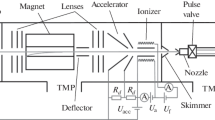Abstract
In this work, a simple way for study the possibility of formation a vapor cluster species of tetrachloroauric acid (HAuCl4), using the laser ablation in the absence of a buffer or reactive atmosphere, and without a postablation supersonic expansion on a commercial matrix assisted laser desorption/ionization time-of-flight mass spectrometer, is reported. Tetrachloroauric acid is known as precursor for the synthesis of gold nanostructures and the complex salts; therefore it is an important task to discover and quantify the species arising from HAuCl4, in order to understand their role in the gold assisted reactions. Mass spectrum of HAuCl4 in a reflector negative-ion mode contains the hydrated mono- and dinuclear gold clusters in the m/z range 286–436, and gold chloride clusters in the m/z range 447–795. In the first part of spectrum, m/z range 286–436, the hydrated gold cluster species of type Au −n (H2O)m (n = 1–2; m = 1, 2, 5, 7, 8) and [Aun(OH)k]−(H2O)m (n = 1–2; k = 1–2; m = 1, 4–8) were found. Besides that, there are gold chloride clusters with general formula [AuHr(HCl)2]−(H2O)m (m = 1–5; 8–9; r = 0–2) in this part of spectrum. In the second part of spectrum, the m/z range 447–795, only gold chloride clusters were obtained. Their general formulae can be written as [AuClt(HCl)v]−(H2O)m (t = 1–4; v = 5–8; m = 2–4, 6–8) and [Aun(HCl)v]−(H2O)m (n = 1–2, v = 4–5, m = 1–2, 5, 7). The analysis of concentration effects on the LDI mass spectra of gold clusters reveals that the relative intensities of signals for the mono- and dinuclear Au clusters increase with decreasing the concentration of water HAuCl4 solutions.




Similar content being viewed by others
References
Acton, Q.A.: Advances in Nanotechnology Research and Application: 2012 Edition. ScholarlyEditions, Atlanta (2012)
Andrews, L., Wang, X.: Infrared spectra and structures of the stable CuH2 −, AgH2 −, AuH2 −, and AuH4 − anions and the AuH2 molecule. J. Am. Chem. Soc. 125, 11751–11760 (2003)
Arakelian, S., Emel’yanov, V., Kutrovskaya, S., Kucherik, A., Zimin, S.: Laser-induced semiconductor nanocluster structures on the solid surface: new physical principles to construct the hybrid elements for photonics. Opt. Quant. Electron. 48, 342 (2016a)
Arakelian, S., Kutrovskaya, S., Kucherik, A., Osipov, A., Povolotckaia, A., Povolotskiy, A., Manshina, A.: Laser-induced synthesis of nanostructured metal–carbon clusters and complexes. Opt. Quant. Electron. 48, 505 (2016b)
Bondybey, V.E., English, J.H.: Laser induced fluorescence of metal clusters produced by laser vaporization: gas phase spectrum of Pb2. J. Chem. Phys. 74, 6978 (1981)
Cheung, J., Horwitz, J.: Pulsed laser deposition history and laser–target interactions. MRS Bull. 17, 30–36 (1992). https://doi.org/10.1557/S0883769400040598
Daniel, M.C.M., Astruc, D.: Gold nanoparticles: assembly, supramolecular chemistry, quantum-size related properties and applications toward biology, catalysis and nanotechnology. Chem. Rev. 104, 293–346 (2004). https://doi.org/10.1021/cr030698
Dietz, T.G., Duncan, M.A., Powers, D.E., Smalley, R.E.: Laser production of supersonic metal cluster beams. J. Chem. Phys. 74, 6511 (1981)
Gibson, J.K.: Laser ablation and gas-phase reactions of small gold cluster ions, Au +n (1 ≤ n ≤ 7). J. Vac. Sci. Technol. A 16, 653 (1998)
Hashimoto, S., Werner, D., Uwada, T.: Studies on the interaction of pulsed lasers with plasmonic gold nanoparticles toward light manipulation, heat management, and nanofabrication. J. Photochem. Photobiol. C Photochem. Rev. 13, 28–54 (2012)
Karas, M., Bachmann, D., Bahr, U., Hillenkamp, F.: Matrix-assisted ultraviolet laserdesorption of non-volatile compounds. Int. J Mass Spectrom. Ion Process. 78, 53 (1987)
Karataev, V.I.: Determining trace amounts of gold in natural samples and chemical compounds. Tech. Phys. Lett. 34, 1082–1084 (2008). https://doi.org/10.1134/S1063785008120286
Lemke, K.H.: Gold chloride clusters with Au(III) and Au(I) probed by FT-ICR mass spectrometry and MP2 theory. Phys. Chem. Chem. Phys. 16, 7813–7822 (2014). https://doi.org/10.1039/c3cp55109a
Liu, H.T., Wang, Y.L., Xiong, X.G., Dau, P.D., Piazza, Z.A., Huang, D.L., Xu, C.Q., Li, J., Wang, L.S.: The electronic structure and chemical bonding in gold dihydride: AuH2 − and AuH2. Chem. Sci. 3, 3286 (2012)
Lowndes, D.H., Geohegan, D.B., Puretzky, A.A., Norton, D.P., Rouleau, C.M.: Synthesis of novel thin-film materials by pulsed laser deposition. Science 273, 898–903 (1996)
Lubman, D.M. (ed.): Lasers and mass spectrometry. Oxford University Press, New York (1990)
McIndoe, J.S.: Laser synthesis of transition metal clusters. Transit. Met. Chem. 28, 122–131 (2003). https://doi.org/10.1023/A:1022515104991
Peña-Méndez, E.M., Hernández-Fernaud, J.R., Nagender, R., Houška, J., Havel, J.: The chemistry of gold clusters in plasma generated with MALDI, laser desorption ionization and laser ablation from various precursors. Chem. Listy 102, s1394–s1398 (2008)
Schwerdtfeger, P., Boyd, P.D.W., Burrell, A.K., Robinson, W.T., Taylor, M.J.: Relativistic effects in gold chemistry. 3. Gold(I) complexes. Inorg. Chem. 29, 3593 (1990)
Yamashita, M., Fenn, J.B.: Electrospray ion source. Another variation on the free-jet theme. J. Phys. Chem. 88, 4451 (1984)
Wang, L.M., Wang, L.S.: Probing the electronic properties and structural evolution of anionic gold clusters in the gas phase. Nanoscale 4, 4038 (2012)
Acknowledgements
This work was funded by the Ministry of Education, Science and Technological Development of the Republic of Serbia (Project No. 172019).
Author information
Authors and Affiliations
Corresponding author
Additional information
This article is part of the Topical Collection on Focus on Optics and Bio-photonics, Photonica 2017.
Guest Edited by Jelena Radovanovic, Aleksandar Krmpot, Marina Lekic, Trevor Benson, Mauro Pereira, Marian Marciniak.
Rights and permissions
About this article
Cite this article
Rajčić, B., Dimitrijević, S.B., Petković, M. et al. Gold chloride cluster ions generated by vacuum laser ablation. Opt Quant Electron 50, 218 (2018). https://doi.org/10.1007/s11082-018-1476-2
Received:
Accepted:
Published:
DOI: https://doi.org/10.1007/s11082-018-1476-2




